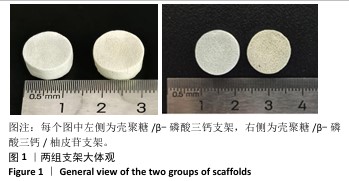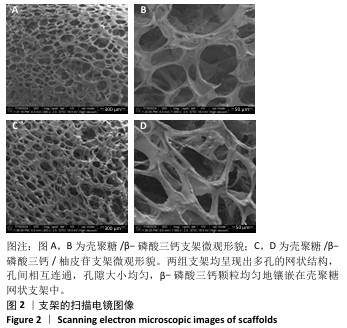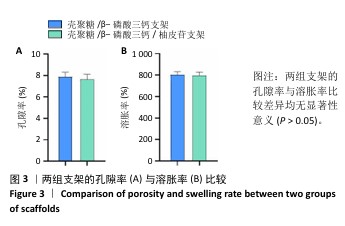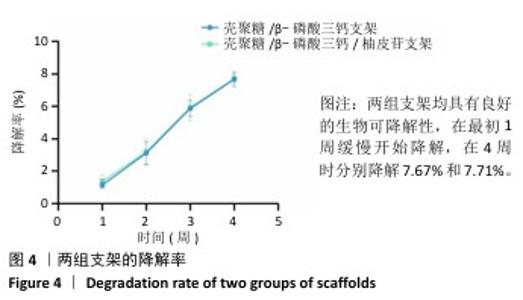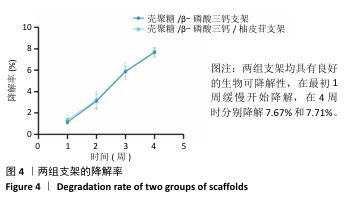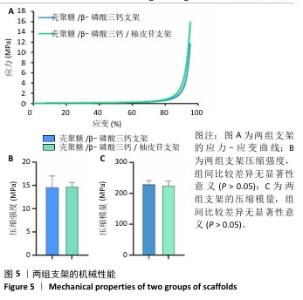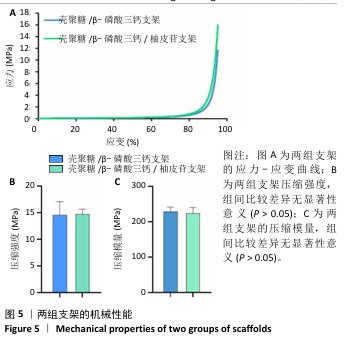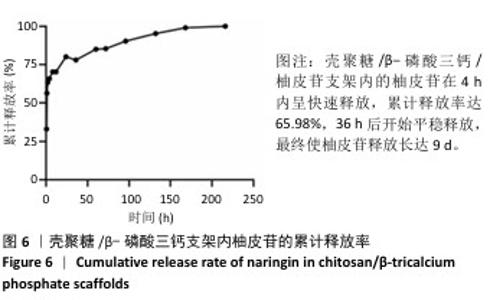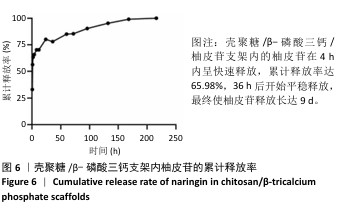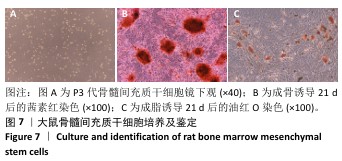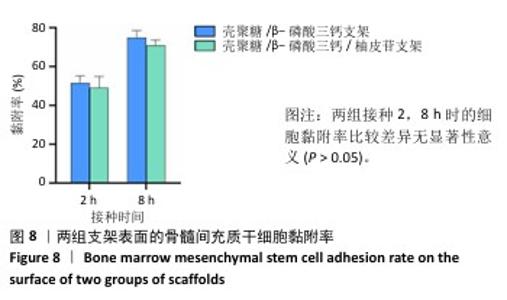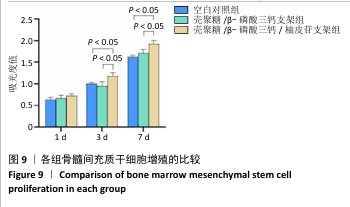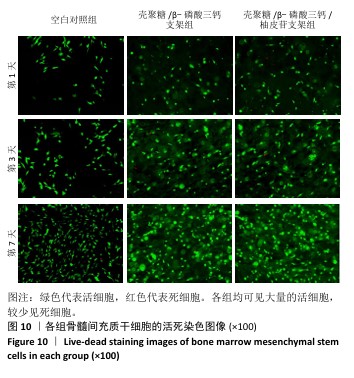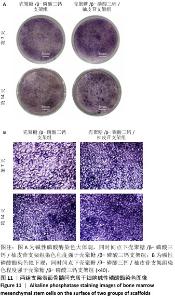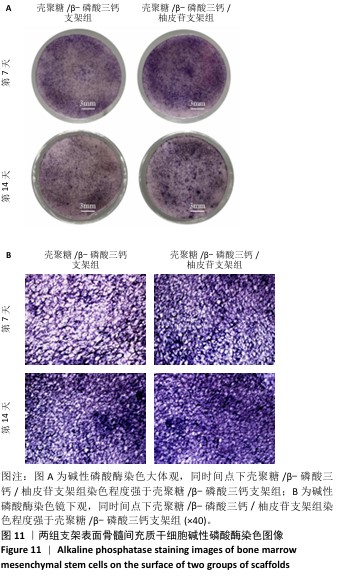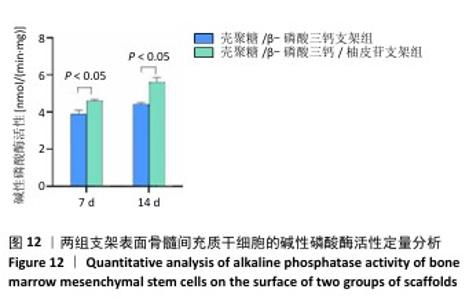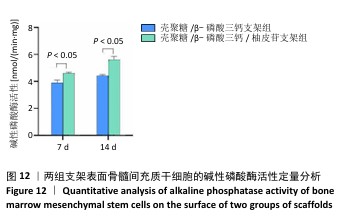Chinese Journal of Tissue Engineering Research ›› 2026, Vol. 30 ›› Issue (2): 424-432.doi: 10.12307/2025.583
Previous Articles Next Articles
Characterization and biological properties of naringin-loaded chitosan/beta-tricalcium phosphate scaffold
Yuan Qian, Zhang Hao, Pang Jie
- Department of Stomatology, Shiyan Renmin Hospital (Affiliated Renmin Hospital of Hubei University of Medicine), Shiyan 442000, Hubei Province, China
-
Received:2024-09-19Accepted:2024-11-14Online:2026-01-18Published:2025-06-20 -
Contact:Pang Jie, MS, Chief physician, Department of Stomatology, Shiyan Renmin Hospital (Affiliated Renmin Hospital of Hubei University of Medicine), Shiyan 442000, Hubei Province, China -
About author:Yuan Qian, Master candidate, Physician, Department of Stomatology, Shiyan Renmin Hospital (Affiliated Renmin Hospital of Hubei University of Medicine), Shiyan 442000, Hubei Province, China -
Supported by:Graduate Science and Technology Innovation Project of Hubei University of Medicine, No. YC2023058 (to PJ)
CLC Number:
Cite this article
Yuan Qian, Zhang Hao, Pang Jie. Characterization and biological properties of naringin-loaded chitosan/beta-tricalcium phosphate scaffold[J]. Chinese Journal of Tissue Engineering Research, 2026, 30(2): 424-432.
share this article
Add to citation manager EndNote|Reference Manager|ProCite|BibTeX|RefWorks
| [1] ZHOU S, XIAO C, FAN L, et al. Injectable ultrasound-powered bone-adhesive nanocomposite hydrogel for electrically accelerated irregular bone defect healing. J Nanobiotechnology. 2024;22(1):54. [2] TAN B, TANG Q, ZHONG Y, et al. Biomaterial-based strategies for maxillofacial tumour therapy and bone defect regeneration. Int J Oral Sci. 2021;13(1):9. [3] CLAES L, AUGAT P, SUGER G, et al. Influence of size and stability of the osteotomy gap on the success of fracture healing. J Orthop Res. 1997;15(4):577-584. [4] GILLMAN CE, JAYASURIYA AC. FDA-approved bone grafts and bone graft substitute devices in bone regeneration. Mater Sci Eng C Mater Biol Appl. 2021;130:112466. [5] ZUFÍA J, ABELLA SF. Applications of maxillary tuberosity block autograft. J Esthet Restor Dent. 2022;34(7):1015-1028. [6] ZHAO R, YANG R, COOPER PR, et al. Bone Grafts and Substitutes in Dentistry: A Review of Current Trends and Developments. Molecules. 2021;26(10):3007. [7] QU H, FU H, HAN Z, et al. Biomaterials for bone tissue engineering scaffolds: a review. RSC Adv. 2019;9(45):26252-26262. [8] 康坤龙,王新涛,生物支架材料促进骨髓间充质干细胞成骨分化的研究热点[J].中国组织工程研究,2022,26(4):597-603. [9] AZIZIAN S, HADJIZADEH A, NIKNEJAD H. Chitosan-gelatin porous scaffold incorporated with Chitosan nanoparticles for growth factor delivery in tissue engineering. Carbohydr Polym. 2018;202:315-322. [10] YAZDIMAMAGHANI M, RAZAVI M, VASHAEE D, et al. Porous magnesium-based scaffolds for tissue engineering. Mater Sci Eng C Mater Biol Appl. 2017;71:1253-1266. [11] BHARADWAZ A, JAYASURIYA AC. Recent trends in the application of widely used natural and synthetic polymer nanocomposites in bone tissue regeneration. Mater Sci Eng C Mater Biol Appl. 2020;110: 110698. [12] FARZAMFAR S, RICHER M, RAHMANI M, et al. Biological Macromolecule-Based Scaffolds for Urethra Reconstruction. Biomolecules. 2023; 13(8):1167. [13] SHI W, ZHANG X, BIAN L, et al. Alendronate crosslinked chitosan/polycaprolactone scaffold for bone defects repairing. Int J Biol Macromol. 2022;204:441-456. [14] ZHOU T, ZHOU H, WANG F, et al. An injectable carboxymethyl chitosan hydrogel scaffold formed via coordination bond for antibacterial and osteogenesis in osteomyelitis. Carbohydr Polym. 2024;324:121466. [15] MUZZARELLI RA, EL MEHTEDI M, BOTTEGONI C, et al. Physical properties imparted by genipin to chitosan for tissue regeneration with human stem cells: A review. Int J Biol Macromol. 2016;93(Pt B): 1366-1381. [16] SANCHEZ-SALVADOR JL, BALEA A, MONTE MC, et al. Chitosan grafted/cross-linked with biodegradable polymers: A review. Int J Biol Macromol. 2021;178:325-343. [17] INDURKAR A, PANDIT A, JAIN R, et al. Plant based cross-linkers for tissue engineering applications. J Biomater Appl. 2021;36(1):76-94. [18] MUZZARELLI RA, EL MM, BOTTEGONI C, et al. Genipin-Crosslinked Chitosan Gels and Scaffolds for Tissue Engineering and Regeneration of Cartilage and Bone. Mar Drugs. 2015;13(12):7314-7338. [19] ZAFEIRIS K, BRASINIKA D, KARATZA A, et al. Additive manufacturing of hydroxyapatite-chitosan-genipin composite scaffolds for bone tissue engineering applications. Mater Sci Eng C Mater Biol Appl. 2021;119:111639. [20] ZHANG L, LI X, SHI C, et al. Biocompatibility and Angiogenic Effect of Chitosan/Graphene Oxide Hydrogel Scaffolds on EPCs. Stem Cells Int. 2021;2021:5594370. [21] BOUWMAN WF, BRAVENBOER N, TEN BC, et al. Tissue Level Changes after Maxillary Sinus Floor Elevation with Three Types of Calcium Phosphate Ceramics: A Radiological Study with a 5-Year Follow-Up. Materials (Basel). 2021;14(6):1471. [22] GUO W, LI B, LI P, et al. Review on vat photopolymerization additive manufacturing of bioactive ceramic bone scaffolds. J Mater Chem B. 2023;11(40):9572-9596. [23] SERRA IR, FRADIQUE R, VALLEJO MC, et al. Production and characterization of chitosan/gelatin/β-TCP scaffolds for improved bone tissue regeneration. Mater Sci Eng C Mater Biol Appl. 2015; 55:592-604. [24] SUN T, FENG Z, HE W, et al. Novel 3D-printing bilayer GelMA-based hydrogel containing BP,β-TCP and exosomes for cartilage-bone integrated repair. Biofabrication. 2023;16(1):015008. [25] UMRATH F, SCHMITT L , KLIESCH SM, et al. Mechanical and Functional Improvement of β-TCP Scaffolds for Use in Bone Tissue Engineering. J Funct Biomater. 2023;14(8):427. [26] TAN J, ZHANG M, HAI Z, et al. Sustained Release of Two Bioactive Factors from Supramolecular Hydrogel Promotes Periodontal Bone Regeneration. ACS Nano. 2019;13(5):5616-5622. [27] FAN J, ZHANG X, KANG M, et al. Complementary modulation of BMP signaling improves bone healing efficiency. Biomaterials. 2023;302: 122335. [28] 张敏,张晓明,刘童斌.柚皮苷在骨组织再生领域的应用潜力[J].中国组织工程研究,2023,27(5):787-792. [29] STABRAUSKIENE J, KOPUSTINSKIENE DM, LAZAUSKAS R, et al. Naringin and Naringenin: Their Mechanisms of Action and the Potential Anticancer Activities. Biomedicines. 2022;10(7):1686. [30] MILES EA, CALDER PC. Effects of Citrus Fruit Juices and Their Bioactive Components on Inflammation and Immunity: A Narrative Review. Front Immunol. 2021;12:712608. [31] PENG Y, QU R, XU S, et al. Regulatory mechanism and therapeutic potentials of naringin against inflammatory disorders. Heliyon. 2024; 10(3):e24619. [32] HAN G, LEE DG. Naringin generates three types of reactive oxygen species contributing differently to apoptosis-like death in Escherichia coli. Life Sci. 2022;304:120700. [33] ZUO Y, LI Q, XIONG Q, et al. Naringin Release from a Nano-Hydroxyapatite/Collagen Scaffold Promotes Osteogenesis and Bone Tissue Reconstruction. Polymers (Basel). 2022;14(16):3260. [34] YU KE, ALDER KD, MORRIS MT, et al. Re-appraising the potential of naringin for natural, novel orthopedic biotherapies. Ther Adv Musculoskelet Dis. 2020;12:1759720X-20966135X. [35] WANG W, MAO J, CHEN Y, et al. Naringin promotes osteogenesis and ameliorates osteoporosis development by targeting JAK2/STAT3 signalling. Clin Exp Pharmacol Physiol. 2022;49(1):113-121. [36] OLIVEIRA ÉR, NIE L, PODSTAWCZYK D, et al. Advances in Growth Factor Delivery for Bone Tissue Engineering. Int J Mol Sci. 2021;22(2):903. [37] ZHENG D, CHEN T, HAN L, et al. Synergetic integrations of bone marrow stem cells and transforming growth factor-β1 loaded chitosan nanoparticles blended silk fibroin injectable hydrogel to enhance repair and regeneration potential in articular cartilage tissue. Int Wound J. 2022;19(5):1023-1038. [38] FAN J, LI J, FAN Q. Naringin promotes differentiation of bone marrow stem cells into osteoblasts by upregulating the expression levels of microRNA-20a and downregulating the expression levels of PPARγ[J]. Mol Med Rep. 2015;12(3):4759-4765. [39] LI F, SUN X, MA J, et al. Naringin prevents ovariectomy-induced osteoporosis and promotes osteoclasts apoptosis through the mitochondria-mediated apoptosis pathway. Biochem Biophys Res Commun. 2014;452(3):629-635. [40] JIANG H, ZHANG M, LIN X, et al. Biological Activities and Solubilization Methodologies of Naringin. Foods. 2023;12(12):2327. [41] RIVOIRA MA, RODRIGUEZ V, TALAMONI G, et al. New Perspectives in the Pharmacological Potential of Naringin in Medicine. Curr Med Chem. 2021;28(10):1987-2007. [42] 梁健,苏睿,宋泉生,等.柚皮苷对骨细胞的作用以及负载柚皮苷的羟基磷灰石复合支架治疗骨缺损的研究[J].医学研究杂志, 2023,52(5):18-20,110. [43] SUKPAITA T, CHIRACHANCHAI S, PIMKHAOKHAM A, et al. Chitosan-Based Scaffold for Mineralized Tissues Regeneration. Mar Drugs. 2021; 19(10):551. [44] YANG L, WANG Q, PENG L, et al. Vascularization of repaired limb bone defects using chitosan-β-tricalcium phosphate composite as a tissue engineering bone scaffold. Mol Med Rep. 2015;12(2):2343-2347. [45] LEKHAVADHANI S, SHANMUGAVADIVU A, SELVAMURUGAN N. Role and architectural significance of porous chitosan-based scaffolds in bone tissue engineering. Int J Biol Macromol. 2023;251:126238. [46] PIAIA L, SILVA SS, GOMES JM, et al. Chitosan/β-TCP composites scaffolds coated with silk fibroin: a bone tissue engineering approach. Biomed Mater. 2021;17(1):015003. [47] KHAN M, RAZAK S, REHMAN S, et al. Bioactive scaffold (sodium alginate)-g-(nHAp@SiO(2)@GO) for bone tissue engineering. Int J Biol Macromol. 2022;222(Pt A):462-472. [48] NARUPHONTJIRAKUL P, PANPISUT P, PATNTIRAPONG S. Zinc and Strontium-Substituted Bioactive Glass Nanoparticle/Alginate Composites Scaffold for Bone Regeneration. Int J Mol Sci. 2023;24(7):6150. [49] ZHAO ZH, MA XL, ZHAO B, et al. Naringin-inlaid silk fibroin/hydroxyapatite scaffold enhances human umbilical cord-derived mesenchymal stem cell-based bone regeneration. Cell Prolif. 2021; 54(7):e13043. [50] BAVYA DK, LALZAWMLIANA V, SAIDIVYA M, et al. Magnesium Phosphate Bioceramics for Bone Tissue Engineering. Chem Rec. 2022;22(11): e202200136. [51] EILBAGI M, EMADI R, RAEISSI K, et al. Mechanical and cytotoxicity evaluation of nanostructured hydroxyapatite-bredigite scaffolds for bone regeneration. Mater Sci Eng C Mater Biol Appl. 2016;68:603-612. |
| [1] | Bai Xiangyu, Huo Feng, Hao Yan, Wang Zecheng, Guo Xiaoyu. Platelet-derived growth factor BB-loaded chitosan/reduced graphene oxide scaffold for repairing alveolar bone defects [J]. Chinese Journal of Tissue Engineering Research, 2026, 30(2): 329-337. |
| [2] | Yan Qiquan, Yang Libin, Li Mengjun, Ni Yazhuo, Chen Keying, Xu Bo, Li Yaoyang, Ma Shiqing, Li Rui, Li Jianwen. Preparation and antibacterial properties of porcine small intestinal submucosal composite nanohydroxyapatite bioscaffold loaded with antimicrobial peptide KR-12-a5 [J]. Chinese Journal of Tissue Engineering Research, 2026, 30(2): 384-394. |
| [3] | Wang Zhuo, Sun Panpan, Cheng Huanzhi, Cao Tingting. Application of chitosan in repair and regeneration of oral hard and soft tissues [J]. Chinese Journal of Tissue Engineering Research, 2026, 30(2): 459-468. |
| [4] | Wang Yu, Fan Minjie, Zheng Pengfei. Application of multistimuli-responsive hydrogels in bone damage repair: special responsiveness and diverse functions [J]. Chinese Journal of Tissue Engineering Research, 2026, 30(2): 469-479. |
| Viewed | ||||||
|
Full text |
|
|||||
|
Abstract |
|
|||||

